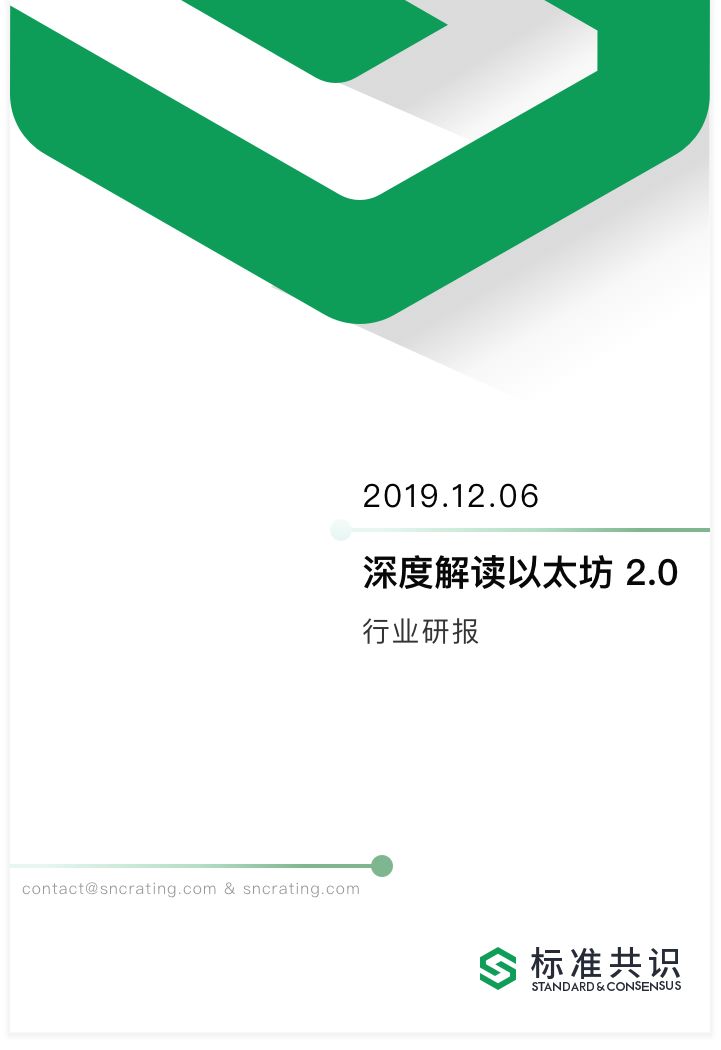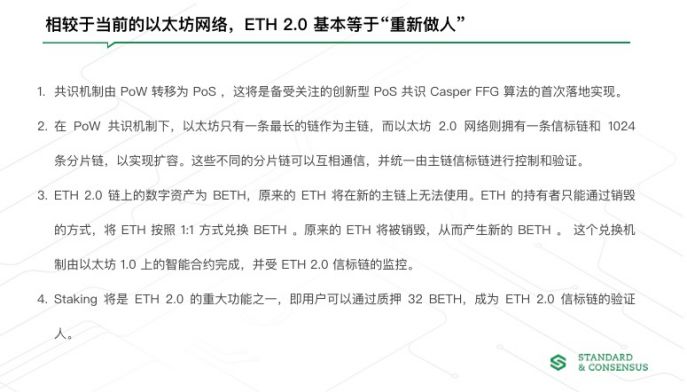An in-depth interpretation of Ethereum 2.0

Overview
V God said at the Ethereum Developers Conference in Prague that Ethereum 2.0 is coming soon and it can increase the Ethereum network's ability to process transactions by a factor of 1,000. This ETH 2.0 update is not an upgrade of the existing network, but a complete innovation of the consensus system of Ethereum, making greater changes to the underlying protocol of the network, especially this time ETH 2.0 will be the first time for the consensus protocol Casper and fragmentation technology The landing will promote the development of blockchain capacity expansion technology and continue to reach commercial standards. This report will explain in detail what Ethereum 2.0 is and what has been updated, and why should we pay attention to it?
Report
What is ETH 2.0?
Ethereum 2.0 is not an upgrade of the existing Ethereum network, but a comprehensive revision and redesign. And the entire renewal plan will last for many years until the final planning goal is completed.
- What is the consensus mechanism of popular science to blockchain
- What challenges does the blockchain face in the real economy? Academic experts think so
- Japanese financial giant SBI considers using XRP to pay shareholder dividends and further strengthens partnership with Ripple

Compared with the current Ethereum network, ETH 2.0 has the following major changes:
- The consensus mechanism was transferred from PoW to PoS. This will be the first implementation of the much-recognized innovative PoS consensus Casper FFG algorithm.
- Under the PoW consensus mechanism, Ethereum has only one longest chain as the main chain, while the Ethereum 2.0 network has a beacon chain and 1024 shard chains to achieve capacity expansion. These different shard chains can communicate with each other and be controlled and verified by the main chain beacon chain in a unified manner.
- The digital asset on the ETH 2.0 chain is BETH. The original ETH will not be available on the new main chain. The holder of ETH can only exchange ETH to BETH in a 1: 1 manner by destroying it. The original ETH will be destroyed, resulting in new BETH. This exchange mechanism is completed by the smart contract on Ethereum 1.0 and is monitored by the ETH 2.0 beacon chain.
- Staking will be one of the major functions of ETH 2.0, that is, users can become a validator of the ETH 2.0 beacon chain by pledged 32 BETH.
Design goals for ETH 2.0
According to the Ethereum 2.0 white paper, its design goals are as follows:
To minimize complexity, even at the cost of some losses in efficiency.
- Simplicity: Minimize complexity, even if it reduces efficiency.
To remain live through major network partitions and when very large portions of nodes go offline.
- Strong and resilient: After the main network is partitioned, when most nodes are offline, the entire system can still run.
To select all components such that they are either quantum secure or can be easily swapped out for quantum secure counterparts when available.
- Persistence: Choose components that are resistant to quantum computing, or use alternative components until available anti-quantum computing components appear.
To utilize crypto and design techniques that allow for a large participation of validators in total and per unit time.
- Security: Increase the total number of validators and the number of participants per unit time through cryptographic and design techniques.
To allow for a typical consumer laptop with O (C) resources to process / validate O (1) shards (including any system level validation such as the beacon chain)
- Decentralization: Allow consumer-grade laptops with processing power of O (C) to process / verify O (1) shards (may be any level of verification on the system, such as a beacon chain).
ETH 2.0 roadmap
Ethereum 2.0 is divided into 7 phases, of which Phase 0 is expected to be released in early 2020.
- Phase 0: PoS beacon chain without shards
- Phase 1: Basic sharding without EVM
- Phase 2: EVM state transition function
- Phase 3: Light client state protocol
- Phase 4: Cross-shard transactions: see here and more
- Phase 5: Tight coupling with main chain security: here and more
- Phase 6: Super-quadratic or exponential sharding

Main features of the upcoming Phase 0 phase
Phase 0 core is a beacon chain without shards and EVM
The Phase 0 phase of ETH 2.0 is mainly to release the "beacon chain". The beacon chain will become the center of the ETH 2.0 ecosystem and the security and verification center of all other shard chains.
Once deployed, the beacon chain will use the Casper FFG algorithm to run the PoS consensus mechanism. The early iteration of the beacon chain was designed to be as simple as possible, so Phase 0 will not have a virtual machine EVM, nor will it support smart contracts, accounts, and asset transfers, nor will it contain any shards.
BETH on the beacon chain cannot be transferred on the chain, which means that users cannot deposit it on the exchange.
BETH new ether will be the token on the beacon chain
The digital asset on the beacon chain is BETH. The current digital asset ETH on the Ethereum main chain cannot be used on the ETH 2.0 chain. There are two main ways to generate BETH:
1) Become a validator through Stake and get BETH rewards;
2) The ETH on the original chain is destroyed by entering the smart contract and exchanging new BETH according to 1: 1, and the original ETH will be destroyed.
Staking validator mode will be turned on
Users can become validators of the Ethereum 2.0 network by pledged 32 BETH on the beacon chain.
At Phase 0, validators will only be able to verify transactions on the beacon chain, because at this stage, 1024 fragment chains have not yet appeared.
Starting from Phase 1, the sharding function of Ethereum will be implemented. The verifier can confirm the transaction information on the 1024 shard chains at the same time.
The beacon chain and each shard chain will use the new PoS consensus algorithm Casper FFG to determine the final block. Casper FFG is a proof-of-stake algorithm that can punish malicious behaviors (such as chain termination and fork), such as confiscation of the digital assets of the taker Stake.
Validator mechanism
The purpose of sharding is to split state information between nodes without requiring any node to have a complete picture of the network. So no verifier can verify all shards. Instead, the beacon chain will coordinate the verification of the shards. Each round (64 blocks or 6.4 minutes), the beacon chain will shuffle the validators and assign them to a shard. A group of validators assigned to a shard is called a committee. The committee is composed of 128 members.
At Phase 0, this means that the beacon chain is reshuffled every six minutes, selected, and the committee responsible for the next six minutes is selected.
In Phase 1, the beacon chain will designate a verifier committee for each of the 1024 shards. This method seems clear but the implementation is very complicated. It involves multi-stage random number generation and a verifiable delay function to further prevent attempts by the steering committee to choose.
Due to the importance of the committee's work, ETH 2.0 randomly selects committees and rotates them frequently. The committee is responsible for ensuring the safety, liveness, and integrity of the shards where they are located, and is responsible for proving the status of the shards on the beacon chain.
They are the only way the beacon chain can obtain the shard status and vice versa. Randomly selecting validators from a pool of validators to form a committee can minimize the likelihood that the entire committee will lie. Rotating committees from time to time can mitigate the harm that a malicious committee can do.
So for malicious validators and validators trying to maximize their benefits, it is difficult for them to choose the committee as a tool to attack the network. In fact, even if they accidentally gain control of the sharding committee, their control cannot exceed 64 blocks.
Conclusion
If Ethereum 2.0 successfully completes the upgrade, it will greatly promote the overall development of the blockchain technology, especially the biggest difficulty of the current public chain expansion. However, it must also be recognized that the overall span of Ethereum 2.0 update is relatively long, technical innovation is high and difficult, and there is still a great deal of uncertainty as to whether it can achieve a stable and secure new generation of underlying public chain goals.
We will continue to update Blocking; if you have any questions or suggestions, please contact us!
Was this article helpful?
93 out of 132 found this helpful
Related articles
- Make wedding dresses for others? Cryptocurrency mining virus may be secretly letting your computer help others mine
- Sheknows | Together, the alliance chain and the public chain have the same goal?
- The last decade of blockchain: Looking back at 2010 to 2020
- Learning to Power: Hainan's Blockchain Development Attracts Global Attention
- 38,000 new addresses added in one day, DeFi and Istanbul upgraded to inject new blood into Ethereum
- Xiao Lei: Blockchain is the next Internet + dollar super system, and the only US opponent is China
- Microsoft blockchain cloud platform Azure launches non-homogeneous tokens to reward active community participants





